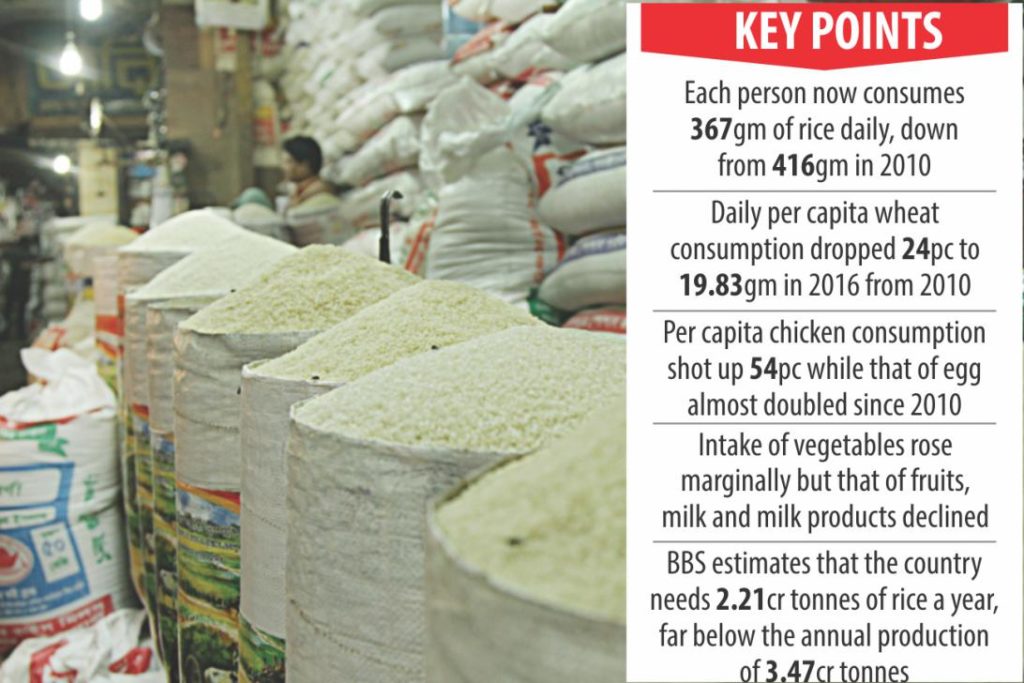Published in The Daily Star on October 23, 2017
BBS survey finds consumption drops 11pc in 5yrs as rising income helps people diversify diets
Per capita rice consumption in Bangladesh declined fast between 2010 and 2016 thanks to increased income that has enabled people to diversify diets with a higher intake of non-cereal foods.
Now, each person consumes 367 grammes of the staple daily, down by 11 percent from 416gm in 2010, according to a preliminary report of the Household Income and Expenditure Survey (HIES) 2016 released at the end of last week.
The Bangladesh Bureau of Statistics (BBS) also found that people reduced their consumption of wheat since 2010. Daily per capita consumption of the grain dropped 24 percent to 19.83gm in 2016 from 26gm in 2010.
Overall, daily intake of rice and wheat by an individual fell by 21 percent and 41 percent from 464.3gm and 33.7gm respectively in 1995-96, according to the HIES 2016.
On the other hand, consumption of some foods other than rice and wheat increased over time. For example, each person consumed 49.5gm of fish in 2010, which rose by 26 percent to 62.58gm in 2016.
Since 2010, per capita consumption of chicken shot up 54 percent while the figure almost doubled in case of eggs, according to HIES.
Akhter Ahmed, country representative of the International Food Policy Research Institute (IFPRI) in Bangladesh, attributed the rise in per capita income to the country’s annual economic growth of 6.5 percent.
“When income grows, consumption of staple food declines and that of other foods increases. This is a good thing that the consumption of chicken and egg is rising. The dietary diversification will be good from the nutritional point of view.”
In Bangladesh, rice still accounts for 70-75 percent of calorie intake and 50 percent of protein, although the grain is not a good source of protein, Ahmed said.
“The rate of fall in rice consumption should be faster than the current trend,” he said.
Based on the HIES 2016 estimate of daily per capita rice intake, overall annual requirement for rice should be 2.21 crore tonnes for the country’s 16.5 crore people. The amount is far below the annual production of 3.47 crore tonnes, as estimated by BBS.
HIES data shows that consumption of cereals declined both in rural and urban areas between 2010 and 2016. People in rural areas eat a higher amount of rice than people in urban areas.
However, daily per capita intake of vegetables increased marginally while fruits, milk and milk products declined during the same period. BBS finds that per capita daily consumption of vegetables, a good source of vitamins and minerals, rose to 167gm in 2016 from 166gm in 2010.
In urban areas, daily consumption increased by 13 percent to 174gm per capita in 2016 from six years ago.
However, daily intake of vegetables by a person in rural areas declined by 3 percent to 164gm during the same period, according to HIES.
Ahmed said increasing urbanisation and incomes propels demand for all sorts of food in urban areas.
“And because of high demand in urban areas, it appears that people in rural areas are sending their produce to towns and cities by consuming less for income. Higher productivity of vegetables would generate surplus and they could consume more of the nutrient-rich food,” he said.
He suggested conducting research on high value crops and development of value chain to increase productivity and curb losses of perishables in the supply chain.
“We have to pay attention to packaging, processing, storage and development of cold chain facilities for better marketing of perishable products. This is vital,” he said, adding that development of a value chain would create jobs for rural youths.
Marketing efficiency will increase and thus losses in the chain will reduce, he said.
He also suggested development of contract farming, which will ensure that the growers are getting reasonable prices for their produce.
Dipankar Roy, project director of HIES at BBS, said increased consumption of non-cereal food was a good sign for the health of the people as well as for the economy.
He said share of peoples’ expenses for non-food items such as education and health rose to 53.3 percent in 2016 from 45.19 percent in 2010. The share of expenditure for food dropped during the same period.
It indicates that the quality of life of people is improving, according to BBS.
 CPD RMG Study Stitching a better future for Bangladesh
CPD RMG Study Stitching a better future for Bangladesh




